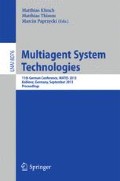Abstract
The Acquired Immunodeficiency Syndrome (AIDS) epidemic has perhaps one of the most complex social structures exhibited by any epidemic. AIDS spread is strongly linked with social networks transgressing cultural, religious and geographical boundaries making it difficult to conduct an objective study. Agent-based Modeling is well-known as an effective method for the exploration and study of complex systems. In this paper, using an example from three different types of populations, we present an Exploratory Agent-based Model (EABM) of AIDS in hybrid populations. Calibrated with data from UNAIDS studies, the model demonstrates how modeling using EABM can be useful to study the complexity in complex social systems in the absence of data of complex interactions. Extensive simulation experiments demonstrate the suitability of this proposed approach to study complex social phenomena.
Access this chapter
Tax calculation will be finalised at checkout
Purchases are for personal use only
Preview
Unable to display preview. Download preview PDF.
References
Barnes, D.M.: Aids research in new phase: The complexity of the aids virus. Science 233(4761), 282–282 (1986)
Bekele, T., Rourke, S., Tucker, R., Greene, S., Sobota, M., Koornstra, J., Monette, L., Rueda, S., Bacon, J., Watson, J., et al.: Direct and indirect effects of perceived social support on health-related quality of life in persons living with hiv/aids. AIDS Care Psychological and Socio-medical Aspects of AIDS/HIV (2012)
Morris, M., Kretzschmar, M.: Concurrent partnerships and the spread of hiv. Aids 11(5), 641–648 (1997)
Johnson, A.M., Mercer, C.H., Erens, B., Copas, A.J., McManus, S., Wellings, K., Fenton, K.A., Korovessis, C., Macdowall, W., Kiran, Nanchahal, o.: Sexual behaviour in britain: partnerships, practices, and hiv risk behaviours. The Lancet 358(9296), 1835–1842 (2001)
Bokhari, A., Nizamani, N.M., Jackson, D.J., Rehan, N.E., Rahman, M., Muzaffar, R., Mansoor, S., Raza, H., Qayum, K., Girault, P., et al.: Hiv risk in karachi and lahore, pakistan: an emerging epidemic in injecting and commercial sex networks. International Journal of STD & AIDS 18(7), 486–492 (2007)
Klovdahl, A.S., Potterat, J.J., Woodhouse, D.E., Muth, J.B., Muth, S.Q., Darrow, W.W.: Social networks and infectious disease: The colorado springs study. Social science & medicine 38(1), 79–88 (1994)
Neaigus, A., Jenness, S.M., Hagan, H., Murrill, C.S., Wendel, T.: Reciprocal sex partner concurrency and stds among heterosexuals at high-risk of hiv infection. Journal of Urban Health, 1–13 (2012)
Adogame, A.: Aids, religion, and the politics of social justice in sub-saharan africa. The Wiley-Blackwell Companion to Religion and Social Justice, 482–495 (2012)
Niazi, M.A.: Complex adaptive systems modeling: A multidisciplinary roadmap. Complex Adaptive Systems Modeling 1(1), 1 (2013)
Holland, J.H.: Studying complex adaptive systems. Journal of Systems Science and Complexity 19(1), 1–8 (2006)
Niazi, M.A., Hussain, A.: Cognitive Agent-based Computing: Exploring Emergent Behavior in Complex Adaptive Systems using Agent-based Modeling and Complex Networks. Springer (2012)
Niazi, M.A.: Towards A Novel Unified Framework for Developing Formal, Network and Validated Agent-Based Simulation Models of Complex Adaptive Systems. PhD thesis (2011)
Nations, U.: Second generation surveillance for hiv: The next decade. Technical report, HASP, Pakistan (2010)
Barré-Sinoussi, F., Chermann, J., Rey, F., Nugeyre, M., Chamaret, S., Gruest, J., Dauguet, C., Axler-Blin, C., Vézinet-Brun, F., Rouzioux, C., et al.: Isolation of a t-lymphotropic retrovirus from a patient at risk for acquired immune deficiency syndrome (aids). Science 220(4599), 868–871 (1983)
Bonabeau, E.: Agent-based modeling: Methods and techniques for simulating human systems. Proceedings of the National Academy of Sciences of the United States of America 99(suppl. 3), 7280 (2002)
Niazi, M., Hussain, A., Baig, A.R., Bhatti, S.: Simulation of the research process. In: Simulation Conference, WSC 2008, pp. 1326–1334. IEEE (Winter, 2008)
Siddiqa, A., Niazi, M., Mustafa, F., Bokhari, H., Hussain, A., Akram, N., Shaheen, S., Ahmed, F., Iqbal, S.: A new hybrid agent-based modeling & simulation decision support system for breast cancer data analysis. In: International Conference on Information and Communication Technologies, ICICT 2009, pp. 134–139. IEEE (2009)
Niazi, M.A., Siddique, Q., Hussain, A., Kolberg, M.: Verification & validation of an agent-based forest fire simulation model. In: Proceedings of the 2010 Spring Simulation Multiconference, Society for Computer Simulation International, p. 1 (2010)
Nagoski, E.: An agent based model of disease diffusion in the context of heterogeneous sexual motivation. PhD thesis, Indiana University (2006)
Atkinson, J.: A simulation model of the dynamics of hiv transmission in intravenous drug users. Computers and Biomedical Research 29(4), 338–349 (1996)
Wilensky, U.: Netlogo (1999)
Axelrod, R.: The complexity of cooperation: Agent-based models of competition and collaboration. Princeton Univ. Pr. (1997)
Fortino, G., Russo, W., Zimeo, E.: A statecharts-based software development process for mobile agents. Information and Software Technology 46(13), 907–921 (2004)
Cossentino, M., Fortino, G., Garro, A., Mascillaro, S.: Passim: a simulation-based process for the development of multi-agent systems. International Journal of Agent-Oriented Software Engineering 2(2), 132–170 (2008)
Author information
Authors and Affiliations
Editor information
Editors and Affiliations
Rights and permissions
Copyright information
© 2013 Springer-Verlag Berlin Heidelberg
About this paper
Cite this paper
Niazi, M.A., Siddiqa, A., Fortino, G. (2013). Modeling AIDS Spread in Social Networks. In: Klusch, M., Thimm, M., Paprzycki, M. (eds) Multiagent System Technologies. MATES 2013. Lecture Notes in Computer Science(), vol 8076. Springer, Berlin, Heidelberg. https://doi.org/10.1007/978-3-642-40776-5_30
Download citation
DOI: https://doi.org/10.1007/978-3-642-40776-5_30
Publisher Name: Springer, Berlin, Heidelberg
Print ISBN: 978-3-642-40775-8
Online ISBN: 978-3-642-40776-5
eBook Packages: Computer ScienceComputer Science (R0)

